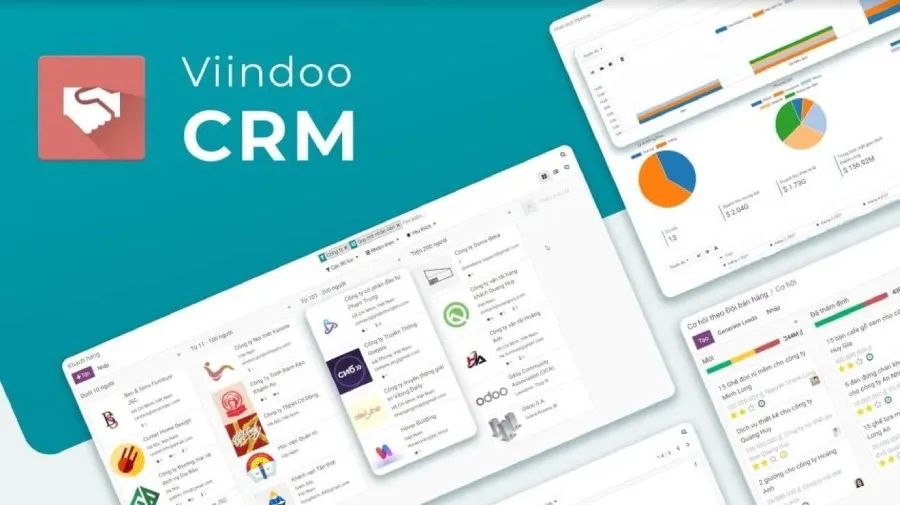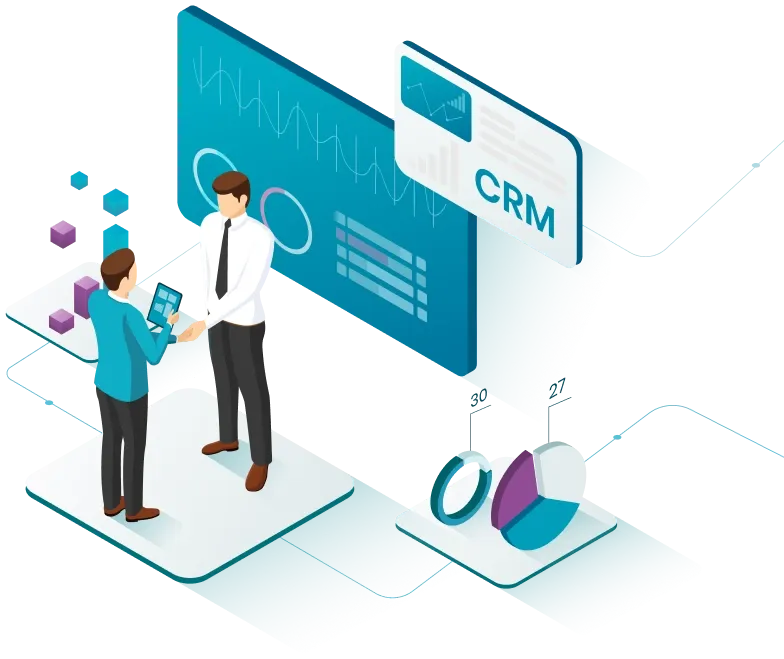Are you struggling with sales pipeline analysis? You're not alone. Understanding the sales pipeline definition and analyzing your pipeline can be challenging, but it's crucial for any successful business. In this article, we'll cover everything you need to know about sales pipeline analysis, including key aspects and examples of tools like Viindoo CRM - Customer Relation management Software.
>>>> See More: Sales management software
What is a Sales Pipeline?
Before we dive into analyzing your sales pipeline, let's define what a sales pipeline is. Simply put, a sales pipeline is a visual representation of the step-by-step process that potential customers go through as they move from being initial prospects to becoming paying customers. It outlines the various stages of the sales process and tracks the progress of individual sales opportunities or deals. The primary purpose of a sales pipeline is to help sales teams manage, monitor, and optimize their interactions with potential customers to increase the likelihood of closing deals and generating revenue.
Key stages typically found in a sales pipeline include:
Lead Generation: Identifying and attracting potential customers who have shown interest in your product or service.
Lead Qualification: Assessing the quality and fit of the leads to determine if they meet the criteria for potential sales.
Needs Analysis: Understanding the specific needs, challenges, and requirements of the potential customer.
Proposal/Presentation: Present a tailored solution or proposal that addresses the customer's needs and demonstrates the value of your offering.
Negotiation: Engaging in discussions to address any concerns, negotiate terms, and finalize the details of the deal.
Closing: Securing the commitment of the customer to make a purchase or take the desired action.
Post-Sale Follow-Up: Providing support, addressing any post-sale concerns, and fostering a positive ongoing relationship.

Sample Sales Pipeline Stages in Viindoo
Sales pipeline management involves tracking and analyzing each deal's progression through these stages, ensuring that no opportunity falls through the cracks and that the sales team can focus efforts on the most promising opportunities. It also helps identify potential bottlenecks, areas for improvement, and opportunities to optimize the sales process.
A well-managed sales pipeline allows sales teams to forecast future revenue, allocate resources effectively, and make informed decisions to drive sales growth and business success.
>>>> See also: What is sales funnel?
Key Aspects of Sales Pipeline Analysis
Analyzing the sales pipeline is part of sales performance analysis and is very important to the success of any business. Key aspects of sales pipeline analysis involve examining various factors and elements within the sales pipeline to optimize its efficiency and effectiveness, including tracking progress, identifying trends, setting goals, and forecasting sales. Here are the key metrics to consider:
Stage Progression Analysis: Evaluate how smoothly leads move from one stage of the pipeline to the next. Identify any bottlenecks or delays that might hinder progression.
Conversion Rates: Analyze conversion rates at each stage to understand how many leads successfully move to the next stage and eventually convert into customers.
Deal Value: Assess the potential value of each deal at different stages to prioritize high-value opportunities and allocate resources accordingly.
Time Spent in Stages: Measure the average time a deal spends in each stage. Identify stages where deals tend to linger, and take actions to expedite their movement.
Lead Source Effectiveness: Determine which lead sources or channels are most successful in generating high-quality leads that progress through the pipeline.
Win/Loss Analysis: Study closed deals to understand why some were won and others were lost. Use this insight to refine your sales strategies and address potential weaknesses.

Key Metrics of Sales Pipeline Analysis
Sales Velocity: Calculate the average time it takes for a deal to move from initial contact to closing. Aim to increase sales velocity by streamlining processes.
Forecasting: Utilize historical data and trends to predict future sales and revenue. This aids in budgeting, resource allocation, and strategic planning.
Team Performance: Analyze how different sales teams or individual salespeople perform within the pipeline. Identify areas for improvement and opportunities for training.
Communication and Follow-Up: Evaluate how effectively the sales team communicates and follows up with leads at each stage, ensuring consistent engagement.
CRM Utilization: Assess how well your Customer Relationship Management software supports pipeline tracking and management. Identify any gaps or areas for improvement in data entry and reporting.
Pipeline Customization: Customize your pipeline stages, labels, and fields to align with your specific business needs and sales process.
Goal Setting: Establish realistic goals for each stage of the pipeline, such as the number of new leads, conversions, or revenue generated.
Continuous Improvement: Regularly review and update your analysis to adapt to changing market conditions, customer behavior, and business goals.
By thoroughly analyzing these aspects of your sales pipeline, you can identify areas for optimization, streamline your sales process, and enhance your overall sales performance and revenue generation.
Sales Pipeline Analysis vs. Sales Funnel Analysis
Sales Pipeline Analysis and Sales Funnel Analysis are related concepts within the field of sales and marketing, but they focus on different aspects of the customer journey and sales process.

Distinguish Sales Pipeline and Sales Funnel Analysis
Here's a breakdown of the differences between the two:
| Aspect | Sales Pipeline Analysis | Sales Funnel Analysis |
|---|---|---|
| Focus | Internal management of individual deals | Entire customer journey from awareness to conversion |
| Scope | Specific sales opportunities | The entire process of customer interaction |
| Purpose | Improve sales process efficiency | Optimize customer journey for higher conversion rates |
| Metrics | Deal value, conversion rates, time in stages | Lead generation, conversion rates, customer behavior |
| Outcome | Increased sales velocity, improved deal management | Better-targeted marketing, enhanced conversion strategies |
| Main Concern | Efficient movement of deals through stages | Customer engagement and conversion optimization |
| Implementation Approach | Tracking and analyzing individual deals | Analyzing the behavior of the entire customer base |
| Key Decisions | Resource allocation, sales team performance | Marketing strategies, customer experience enhancement |
| Tools and Software | CRM systems, sales tracking software | Marketing automation, analytics platforms |
| Timeframe | Short-term optimization of specific deals | Long-term enhancement of the overall customer journey |
Remember that the choice between these analyses depends on your business goals and the specific insights you're seeking to gain. Both approaches can be valuable for improving sales and customer engagement, but they address different stages and aspects of the sales process.
Sales Pipeline Analysis Tool Example with Viindoo CRM Software
One excellent example of a sales pipeline analysis tool is Viindoo CRM Software. This cloud-based software allows you to track every stage of your sales pipeline, from lead generation to post-sale follow-up, all in one place.

Viindoo CRM Software - A tool for sales pipeline analysis
Here's how Viindoo software can potentially serve the key analysis aspects of the sales pipeline:
Goal Setting: You can set up goals and targets for your sales team in Viindoo CRM, helping to align efforts with your desired outcomes.
Pipeline Customization: Viindoo CRM is customizable, allowing you to tailor pipeline stages and fields to align with your unique sales process.
Stage Progression Analysis: Viindoo's CRM module allows you to define custom stages for your sales pipeline. You can track the progression of deals through these stages and visualize how leads move from one stage to another.
Conversion Rates: Viindoo CRM provides conversion rate tracking with the Sankey Diagram, showing you the rate of leads that move from one stage to another. You can analyze these rates to understand where leads tend to drop off and make adjustments accordingly.

Viindoo Sankey Diagram for Sales Pipeline Conversion Rates Tracking
Deal Value: You can assign values to deals in Viindoo CRM, allowing you to track and analyze the potential revenue associated with each deal as it progresses through the pipeline.

Viindoo CRM - Expected Deal Revenue
Time Spent in Stages: Viindoo CRM allows you to track some critical Time Spent metrics such as Days to Convert a lead to an opportunity in the pipeline, Days to Assign a lead/opportunity to a salesperson, Days to Close, and Exeeded Closing Days.

Viindoo CRM - Critical Time Spent Metrics
Lead Source Effectiveness: Viindoo CRM lets you associate leads with specific lead sources, helping you identify which sources generate the most successful deals.

Viindoo CRM - Lead Source Analysis report
Win/Loss Analysis: By recording the outcomes of deals in Viindoo CRM, you can analyze won and lost deals to identify patterns and reasons behind success or failure.

Viindoo CRM -Win/Loss Ratio in Pipeline Analysis Report

Viindoo CRM - Lost Reason Analysis
Sales Velocity: With data on deal creation dates and closure dates, you can calculate sales velocity in Viindoo CRM and monitor trends over time.

Viindoo CRM - Cohort Analysis for Days to Close Leads
Forecasting: Viindoo CRM provides reporting and analytics features that can help you forecast future sales based on historical data and trends.

Viindoo CRM - Forecasting Report
Team Performance: Viindoo CRM enables you to assign leads and opportunities to specific salespeople, making it easier to track individual and team performance.

Viindoo CRM - Sales Team Performance
Communication and Follow-Up: Viindoo CRM's integrated communication tools facilitate communication and follow-up with leads directly within the software.

Viindoo CRM - Integrated Communication with Customers via Email

Viindoo CRM - Follow-up activities
CRM Utilization: Viindoo CRM centralizes customer data, interactions, and communication, making it easier to maintain accurate records and generate reports.
Continuous Improvement: Viindoo's reporting and analytics capabilities allow you to regularly monitor and adjust your sales strategies based on real-time data and insights.
It's important to keep in mind that the extent to which Viindoo serves these key analysis aspects can depend on factors such as the specific modules you're using, the version of Viindoo, and any customization or integration you've implemented. It's recommended to work closely with your Viindoo implementation team or consultant to ensure that your sales pipeline analysis needs are effectively addressed within the Viindoo software.
FAQs
Why is understanding the sales pipeline important?
Understanding the sales pipeline is crucial for managing and optimizing the sales process, ensuring efficient movement of deals, and increasing the likelihood of closing deals and generating revenue.
How does sales pipeline analysis benefit businesses?
Sales pipeline analysis helps businesses identify bottlenecks, optimize the sales process, forecast future revenue, allocate resources effectively, and make informed decisions to drive sales growth.
How does Viindoo CRM Software assist with sales pipeline analysis?
Viindoo CRM Software provides tools for goal setting, customization of pipeline stages, tracking stage progression, conversion rate analysis, deal value assessment, sales velocity calculation, forecasting, team performance evaluation, communication and follow-up tracking, and CRM utilization.
Is Viindoo CRM software easy to use?
Yes, Viindoo CRM is designed to be user-friendly and easy to use. We offer training and support to help users become familiar with the software and its features.
How much does Viindoo CRM software cost?
Viindoo CRM is free forever for first application with unlimited users. Checkout here: https://viindoo.com/pricing
Conclusion
In conclusion, sales pipeline analysis is crucial for any successful business. By analyzing your pipeline, tracking progress, identifying trends, setting goals, and forecasting sales, you can make data-driven decisions that will improve your sales performance. Tools like Viindoo CRM Software can simplify the process and provide valuable insights into your sales pipeline. So start analyzing your sales pipeline today and see the positive impact it can have on your business.

All-in-one CRM Software Solution
FREE FOREVER
Optimize your Sales Pipeline Analysis with Viindoo CRM.
